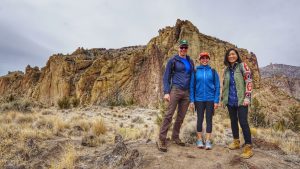Equitable Access to Washington State Parks: Identifying Underrepresented Populations and Barriers to Visitation
Short Summary:
Our state parks are a beautiful resource that everyone deserves to enjoy. However, traditionally privileged groups – such as those who are white, wealthy, and older – are visiting more than disadvantaged groups – including people of color, low-income, and young adults. In order to rectify this disparity and welcome a more diverse population into parks we will need to address the barriers of cost, lack of information, and weak cultural connection. By developing programs that target these barriers and support community organizations, we can ensure that a broad and diverse population can experience and advocate for our parks.
WHY I DID IT:
Washington is renowned for our beautiful outdoor spaces and state parks are our most visited non-urban public lands. Spending time in these parks has been proven to decrease stress and increase activity levels, among other health benefits, while enriching our lives through the exploration and appreciation of nature. However, anecdotal observations had led me to suspect that state parks may be suffering from an overly homogenous visitor population that is largely retired and white. This concerned me, since other populations may be underrepresented among visitors, meaning that some demographics lack the opportunity to enjoy our parks. Not only would these people not be able to experience the physical and mental benefits of being outdoors, but they will also not develop a personal connection with nature. Without an appreciation for public parks, we can’t expect others to see why they are a valuable resource that is worth protecting.
HOW I DID IT:
Through my internship with the Washington State Parks Foundation – in addition to surveying every state park agency and foundation, as well as developing infographics and data visualizations about state parks – I set out to determine whether certain populations were being underrepresented among state park campers and what barriers those populations were experiencing to discourage visitation. I conducted an original analysis of thousands of survey responses from state park visitors and campers that had been collected by the Washington State Parks & Recreation Commission and compared their demographic composition with Washington residents. I also reviewed literature discussing the degree of representation among visitors to public lands across the country, including Washington’s National Forests, Oregon State Parks, and the National Parks Service. Finally, to supplement my quantitative findings I interviewed staff members from three state parks across the country, learning how each state was navigating issues of equity and accessibility.
WHAT I DISCOVERED:
Based on my data analysis comparing state park campers with Washington residents, I found that campers are at a 20% higher chance of being non-Hispanic white, 28% more likely to be over the age of 45, and 14% more likely to make over $100,000 in annual household income. On the other hand, people of colour, under the age of 25, and making less than $50,000 are less likely to camp at state parks. From my literature review and interviews I found that these underrepresented populations experience the barriers of cost, lack of information, and weak cultural connection. However, these barriers could be overcome through targeted programming and supporting community groups that are already tackling these issues. By supporting efforts to increase equitable representation in parks, they will flourish from a broad and diverse community of advocates who have a personal connection with nature and believe it is worth protecting.
WHAT I LEARNED:
- To craft interactive, engaging, and informative data visualizations using Tableau software that can be used to advocate for funding and policy initiatives
- To design concise, effective, and aesthetically pleasing infographics that communicate a specific narrative to the audience
- To manipulate large sets of data, isolate useful information, and interpret them in a format that is easily digestible to the general public
- To effectively communicate my work through oral presentations
- To collaborate with an array of stakeholders and experts in order to serve a mutual goal
- To conduct professional phone interviews
The Big Picture:
State parks are among Washington’s most beautiful natural resources, yet this beauty is wasted if not everyone has the chance to visit them. With people of colour, lower-income, and young adults visiting parks less, we must implement better programs that encourage more diverse populations to visit and support parks.
